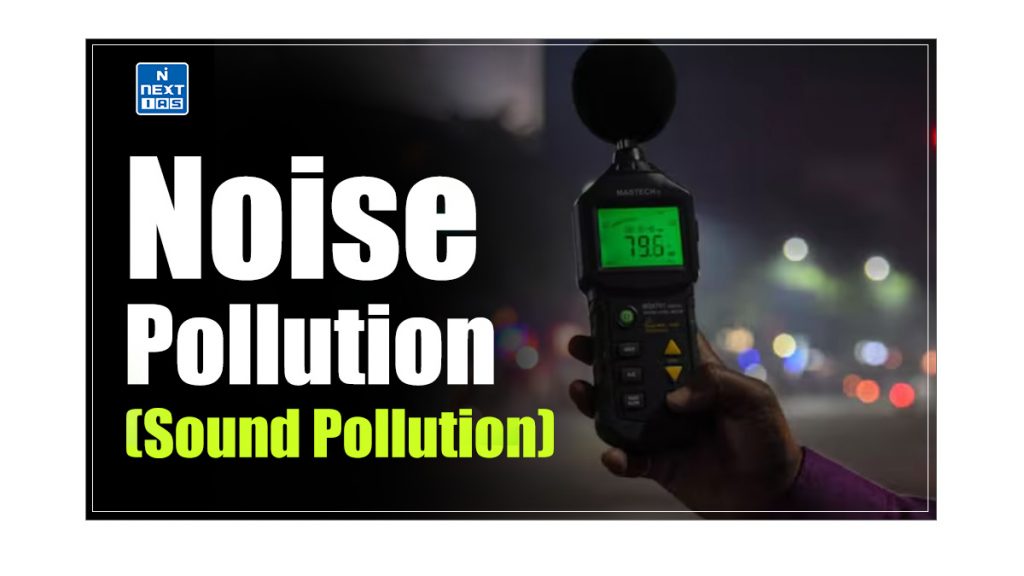
As societies become increasingly industrialised and urbanised, Noise Pollution, also known as Sound Pollution, has emerged as a significant environmental issue. It has wide-ranging implications for human health, wildlife, and the environment. This article aims to study in detail Noise Pollution (Sound Pollution), its major sources, effects, control measures, and other related aspects.
About Noise Pollution (Sound Pollution)
- According to the Indian Government, sound levels above 50dB and 40dB during the day and night are considered Noise Pollution.
- Noise Pollution, also called Sound Pollution, is a prominent type of Environmental Pollution.
What is Noise?
- Any sound that creates discomfort to the recipient is termed Noise.
- Noise as a potent menace is measured in terms of decibels (dB).
- However, the health hazard is a matter of Perceived Noise level in decibels (PNdB).
- WHO (World Health Organization) has prescribed an optimum noise level of 45 dB during the day and 35 dB at night.
- Anything above 80 dB is hazardous.
- The table below gives the noise intensity in some of the common activities.
| Source | Intensity |
|---|---|
| Breathing | 10 dB |
| Winds of trees | 20 dB |
| Quiet Conversation | 20-30 dB |
| Radio Music | 50-60 dB |
| Loud Conversation | 60 dB |
| Traffic Noise | 60-90 dB |
| Vacuum Cleaner | 80 dB |
| Aircraft Noise | 90-120 dB |
| Motor Cycle | 105 dB |
| Thunder Storm | 110 dB |
| Jet Engine | 140 dB |
| Space Vehicle Launch | 140-170 dB |
| What is Environmental Pollution? – Environmental Pollution refers to the introduction of harmful materials into the environment. – In other words, it is the contamination of the physical and biological components of the environment to such an extent that normal environmental processes are adversely affected. – Environmental pollution can be categorised into several types based on the nature of the pollutants and the media they affect, including Air Pollution, Soil Pollution, Water Pollution, etc. Read our detailed articles on Environmental Pollution, Soil Pollution, Water Pollution, Air Pollution, Thermal Pollution, Nuclear Pollution, Marine Pollution, and Plastic Pollution. |
Sources of Noise Pollution
- All human activities contribute to noise pollution to varying extent.
- Noise pollution is more common in urban areas due to a higher concentration of population, industries, and activities such as transportation.
- Like other pollutants, noise is a by-product of industrialisation, urbanisation and modern civilisation.
- Variety of sources of noise pollution can be categorised into two types – Indoor Sources and Outdoor Sources.
Indoor Sources
- The noise produced by radio, television, generators, electric fans, air coolers, air conditioners, different home appliances, family conflicts, etc, makes up indoor sources of noise pollution.
Outdoor Sources
- Indiscriminate use of loudspeakers, industrial activities, automobiles, traffic, aeroplanes and activities such as those during religious, social and cultural functions.
- In rural areas, farm machines and pump sets are the main sources of noise pollution. During festivals, marriages and many other occasions, the use of firecrackers contributes to noise pollution.
- Noise can also arise from natural sources like thunder.
Causes of Noise Pollution
- A variety of human activities and environmental factors cause noise pollution.
- Urbanisation and industrialisation are major contributors to traffic noise, including cars, buses, trains, and aeroplanes, creating constant background noise in cities.
- Construction activities, such as drilling, hammering, and heavy machinery use, also add to the noise levels. 4
- Industrial operations, especially in factories and power plants, produce high-decibel sounds that can harm nearby communities.
- Household appliances like washing machines, vacuum cleaners, and music systems contribute to indoor noise pollution.
- Additionally, public events, loudspeakers, and social gatherings increase noise pollution in both urban and rural settings.
- Lastly, natural events like thunderstorms or volcanic eruptions, though less frequent, also contribute to noise pollution.
Effects of Noise Pollution
- People exposed to noise levels reaching 110 dB may experience mental trauma, physical fatigue, deafness, hypertension and insomnia.
- Prolonged exposure to noise for a day alone may lead to severe mental disorientation and, in a few cases, result in violent behaviour.
- If noise exposure is not controlled, it may lead to permanent loss of hearing, miscarriage in pregnant ladies and coronary heart diseases.
Measures to Control Noise Pollution
The pervasive noise pollution can be controlled only through cooperation between all the stakeholders, i.e. individuals, families, society and the Government. The following steps can be taken to control or minimise noise pollution:
- TVs, radio and other electronic gadgets should not be played at a high volume.
- Restricting the use of loudspeakers and amplifiers. For example, several states have protocols for maximum sound limits during the nighttime.
- The use of firecrackers, which are noisy and cause air pollution, should be restricted.
- Green belts are created through the plantation of trees along highways.
- Proper lubrication and timely maintenance of industrial machines and transport vehicles.
- Innovative designs and adequate maintenance of vehicles.
- Acoustic materials that can absorb sound energy can be used to interrupt the path of sound.
- Creating noise mounds, noise attenuation walls, well-maintained roads and smooth surfacing of roads can ensure noise abatement.
- Retrofitting locomotives, continuously welded rail tracks, the use of electric locomotives, or the deployment of quieter rolling stock will reduce train noises.
- Appropriate insulation and introduction of noise regulations for take-off and landing of aircraft.
Conclusion
Noise Pollution is a growing concern with significant implications for health, environment, and quality of life. Addressing this issue requires a multifaceted approach involving regulatory measures, technological innovations, and public awareness. By understanding the sources and impacts of noise pollution and implementing effective solutions, societies can work towards a quieter, healthier, and more sustainable future.
Frequently Asked Questions (FAQs)
What is Noise Pollution?
Noise pollution refers to harmful or excessive levels of noise in the environment, which can disrupt human and animal life and lead to adverse health effects.
What is Noise?
Noise is unwanted or disturbing sounds that can interfere with normal activities, such as sleeping, conversation, or work.
What are the causes of noise pollution?
Noise Pollution causes include traffic, industrial activities, construction work, loudspeakers, household appliances, and public events.
What are the effects of noise pollution?
Noise Pollution effects include hearing loss, sleep disturbances, stress, reduced productivity, and cardiovascular issues.
What are the sources of noise pollution?
Major sources of Noise Pollution include vehicles, airplanes, industrial machinery, construction sites, and loud entertainment systems.
How to prevent noise pollution?
Preventive measures of Noise Pollution include using soundproofing, enforcing noise control regulations, limiting the use of loud machinery, and promoting quieter transportation options.






